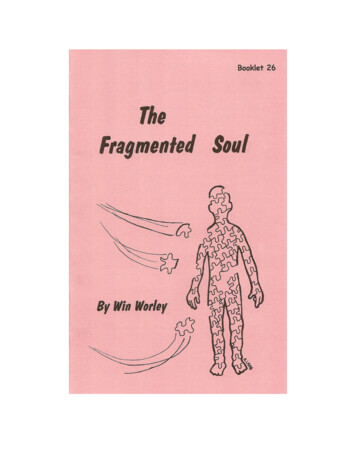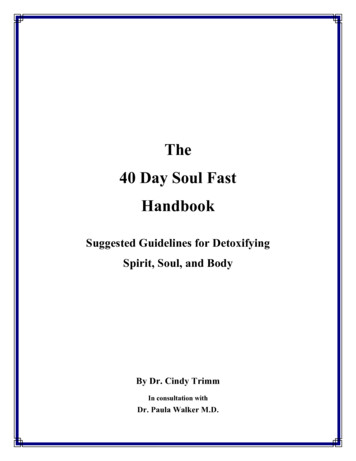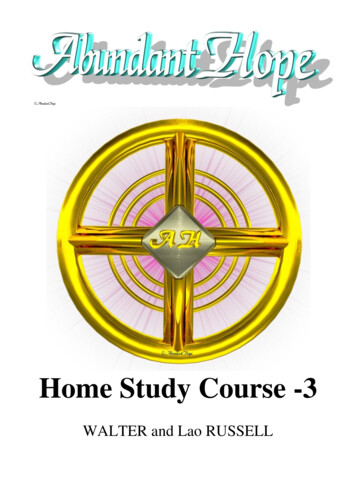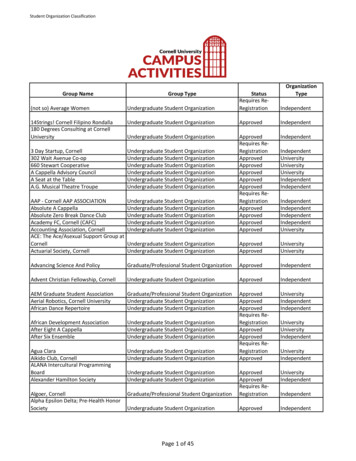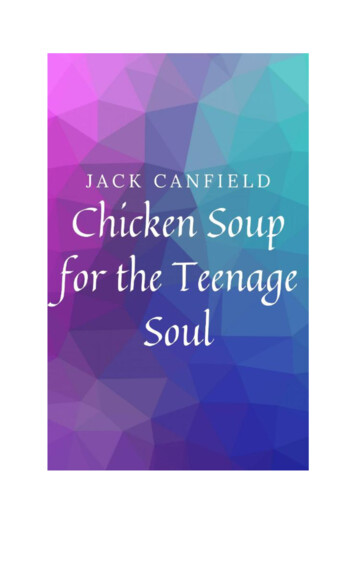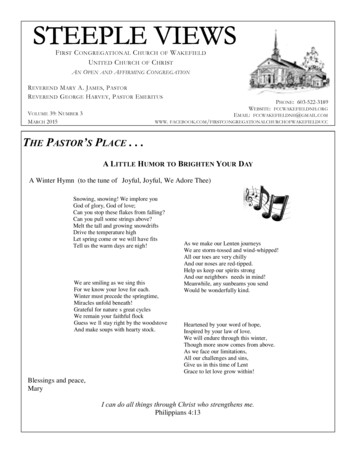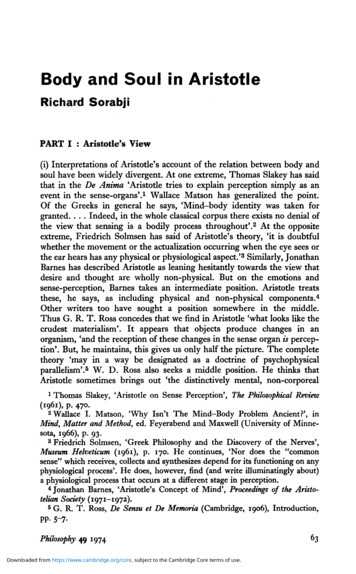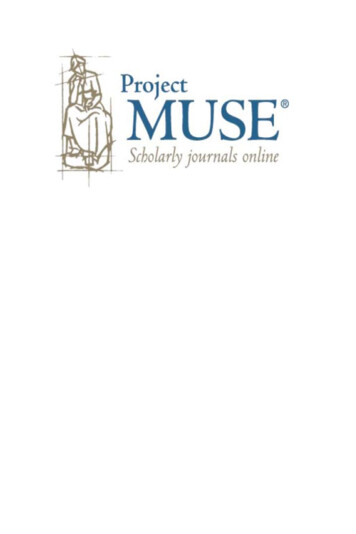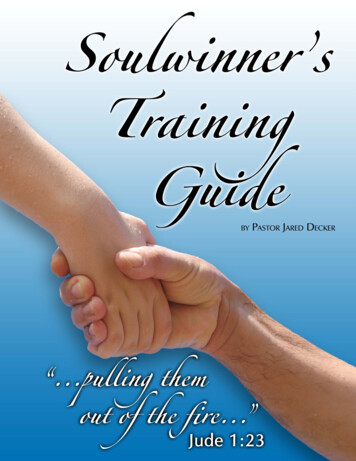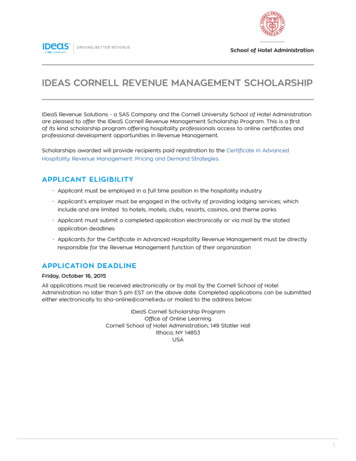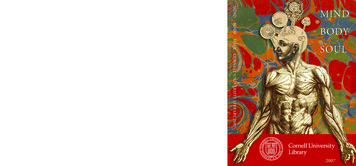
Transcription
MINDMINDBODYBODYSOUL CORNELL UNIVERSITY LIBRARY 2007SOUL2007
Images and Photos2007 Library AdministrationPage:1, Anne R. Kenney, Carla DeMello2 Lightning over Libe Slope, Christine Michelle Buffalow4, Amazing Stories, August 1926, Division of Rare and Manuscript Collections (RMC)5, De Tripl. Anim. In Corp. Vision, 1617, (RMC)7, May 31, 2007 Back Page, Cornell Chronicle9, Grunewald New Year’s Menu, (RMC)11, Fuller Calculator, Lynn Bertoia12, Franklin D. Roosevelt at Cornell University, (RMC)13, Book plate design for Susan Tane, Carla DeMello14, Lord Kelvin, 2007 Jupiterimages Corporation17 Cover of Constitution and Laws of the Commonwealth of Liberia, 1846, Courtesy of the Cornell LawLibrary21, Tertia musculorum tabula, (RMC)23, Mann Library atrium, University Photography24, Olin Library, Carla DeMello27, 2007 New Student Reading Project Poster, Carla DeMello30, Fortune Cookie, Carla DeMello34, Ezra Cornell, (RMC)40, Lost in the Sensation, Marcel Lopez41, Fuerst Award Winners, Kelly Alnutt43, October 19, 2007, Cornell Chronicle45, Frank Sinatra Album, Carla DeMello47, LIBRARY LION. Text 2006 by Michelle Knudsen.Illustrations 2006 by Kevin Hawkes. Reproduced bypermission of the publisher, Candlewick Press, Inc.48, Claire Germain and Vincent Lamanda50, Map, Travis DeMello53, Blue Jay, Kirsten H., Great Falls, MT54, Big Red C, created and photographed by Buzz Spector55, H. N. Humphreys, 1841 Courtesy of Mann Library59, Libe Slope with Cows, 1891, (RMC)60, Uris Library Loading Dock, Carla DeMello61, Passiflora Caerulea, Liberty Hyde Bailey, (RMC)Photos not otherwise credited were provided by Cornell University Photography.Anne R. Kenney(Interim University Librarian through March 2008)Carl A. Kroch University LibrarianWriters and Editors: Ellen Marsh, Chris Philipp: Library Communications, The Chronicle staffGraphic Designer: Carla DeMelloSubstantial contributions by Cornell University Library staffJohn SaylorInterim Associate Librarian for ScholarlyCommunication and CollectionsProduced by Library CommunicationsEdward S. WeissmanAssistant to the University LibrarianLee T. CartmillDirector, Finance and AdministrationElaine EngstDirector, Division of Rare and Manuscript CollectionsClaire E. GermainEdward Cornell Law LibrarianSusan MarkowitzDirector, Library Human ResourcesEllen MarshDirector, Library CommunicationsJanet McCueAssociate University Librarian for Life SciencesJean PolandAssociate University Librarian for Subject LibrariesCarolyn ReidDirector, Weill Cornell Medical LibraryOya RiegerInterim Assistant University Librarian for DigitalLibraries and Information TechnologiesJennifer SawyerDirector, Library Alumni Affairs and DevelopmentCornell University is an equal opportunity, affirmative action educator and employer.Printed on Recycled Paper Cornell University Library03/08 5000 FLPScott WicksInterim Assistant University Librarian for TechnicalServicesContact InformationCornell University Library201 Olin LibraryIthaca, NY 14853-5301Ph: 607 255-3393Fax: 607 255-6788
Message from the University LibrarianApril 1, 2008As a child, I was fascinated with an anatomybook containing several transparencies that revealed layers of the human body, beginning withthe skin, then the muscles, moving on to theskeleton and vital systems. This annual reportreminds me a little of that book. We’ve chosen atheme of mind, body and soul. It’s easy to thinkof the Library as a place of the mind. From thebeginning, its chief function has been to assemble and preserve the collective wisdom containedin books, manuscripts and other documentary forms. But the Library also serves a corporeal role. Its 20 locations are destination points, physical places where people come to gather and consult, to learn, conduct research and to producescholarship and creative expression. Finally, the Library serves as a sourceof inspiration that feeds the soul. Curling up in a chair in the A.D. WhiteLibrary overlooking Cayuga Lake on a snowy winter morning, one can bereplenished through daydreams. Attend a lecture or view an exhibit andmake a connection with things beyond the daily drill. Pull a book off ashelf, listen to a sound recording or examine an 18th century map and bereminded that existence transcends the 80 years or so we’re given.It is more than fitting that on the 200th anniversary year of Ezra Cornell’sbirth, Motto magazine named his pledge to found a university where “anyperson can find instruction in any study” as the number one college motto in the nation. Andrew Dickson White, the university’s co-founder anda known bibliophile, knew that making good on such a promise would require an extraordinary library. And that remains true in the first decade ofthe 21st century. White might fail to appreciate all the changes of the last100 years, but he would certainly recognize that the Library continues toserve as "the heart of the university."Anne R. KenneyCarl A. Kroch University Librarian
Cornell University Library 2007Adelson (Ornithology) LibraryCarl A. Kroch LibraryMartin P. CatherwoodLibrary (Industrial and LaborRelations)Law LibraryEdna McConnell ClarkPhysical Sciences LibraryFrank A. Lee Library, NewYork State AgriculturalExperiment Station at GenevaAlbert R. Mann LibraryJohn Henrik Clarke AfricanaLibraryComstock Memorial Libraryof EntomologyMathematics LibraryNestlé (Hotel) LibraryJohn M. Olin LibrarySidney Cox Library of Musicand DanceDivision of Rare andManuscript CollectionsEngineering LibraryUris LibraryFine Arts LibraryFlower-Sprecher VeterinaryLibrarySamuel J. Wood Library/C.V.Starr Biomedical InformationCenter, Weill Cornell MedicalCollegeJohnson Graduate School ofManagement Librarywww.library.cornell.edu
Mind“the ideas of a great university and a greatlibrary are inextricably linked”A.D. White, Cornell University’s co-founder and first presidentcollectionsresearchscholarship
collectionsFood for ThoughtPreserving the Past; Vision for the FutureDonations from Paul Breitenbach’92 and Andrew Willet ’92 to theDivision of Rare and ManuscriptCollections (RMC) have greatlyenriched the Library’s holdings inthe area of comic design and publishing. Willet’s donation of morethan 5,000 individual comic booktitles, and Breitenbach’s gift of morethan 10,000 hand-drawn newspaper comic strips and related materials from the 1940s to the 1980swill provide enjoyment and instruction for future generations of scholars studying art, culture, design andpublishing.“Comics as we know them todayare an American art form that academia has only recently begun tostudy and in order to study the fieldthere must be primary source material for students to examine,” Willetsaid. “Look at the development ofthe art, of renderings of the humanform; look at the changing culture6the stories reflect; look at what isbeing advertised, and to whom, andhow. I hope that future readers findas many things to enjoy in them as Idid—even if sometimes it’s only thethrill of finding out what happensnext.”Gifts such as these are a boon to theLibrary’s collections, which increasingly document contemporary culture as well as people and events ofthe distant past. According to Katherine Reagan, the Ernest L. SternCurator of Rare Books and Manuscripts and RMC’s assistant directorfor collections, “The Library tries tobe creative in imagining not onlywhat today’s scholars need for theirwork, but also what future scholarswill want to consult so that CornellUniversity Library will remain a vital center for the study, enjoymentand preservation of our culturalheritage.”
16 May 31-June7, 2007 Cornell ChronicleComic artFrom Cicero’s Cat to Swamp Thing,alum-donated collection promptschuckles in library archiveBY KATHERINE REAGANRecent gifts of comic art from twomembers of Cornell’s Class of 1992have not only brought some laughter into the rare book vault at CornellUniversity Library but also some primarysources – comic strips and comic books– for scholars studying art and culture.The Newspaper Comic Art Collection,donated by Paul Breitenbach ’92, preservesan archive of more than 10,000 originalsof newspaper comic strips and relatedmaterials from the 1940s through the1980s. The collection documents the workof such cartoonists as Al Smith, who drewthe strips Mutt and Jeff and Cicero’s Cat,and Tony DiPreta, best known for takingover the comic strip Joe Palooka from itsoriginator, Ham Fisher.Not all comics are necessarily funny,though, as illustrated by a gift from Andrew Willet ’92, a dedicated collector ofcomic books since the early 1980s – fromclassic superhero comics to more obscureunderground works – who donated hispersonal collection of more than 5,000individual titles to the library.“Comics as we know them today arean American art form that academia hasonly recently begun to study; and in orderto study the field there must be primarysource material for students to examine,”Willet said. “Look at the development ofthe art, of renderings of the human form;look at the changing culture the stories reflect; look at what is being advertised, andto whom and how. I hope that future readers find as many things to enjoy in themas I did – even if sometimes it’s only thethrill of finding out what happens next.”These gifts are a boon to the library’sDivision of Rare Book and ManuscriptCollections, which increasingly documents contemporary culture. The divisiontries to be creative in speculating on notonly what today’s scholars need for theirwork but also what future scholars willwant to study so that Cornell UniversityLibrary will remain a vital center for thestudy, enjoyment andpreservation of ourculturalheritage.Katherine Reaganis the Ernest L. Stern Curator of RareBooks and Manuscripts and assistant directorfor collections in the library’s Division of RareBook and Manuscript Collections.ALL IMAGES: DIVISION OF RARE AND MANUSCRIPTCOLLECTIONS, CORNELL UNIVERSITY LIBRARY/PROVIDED7
Feast on MemoriesCan’t remember what you had for dinner at the restaurant you went tofor your 16th birthday or the night you got engaged? The online restaurant menu database created and maintained by the Nestlé Hotel Library contains 7,886 rare and current llections/menusFrom Poet to BenefactorA recently acquired collection of Third World Press books at the Africana Library features works by well-known authors such as GwendolynBrooks and John Henrik Clarke, the library’s namesake. The collectionwas donated by Haki R. Madhubuti, founder and publisher of ThirdWorld Press and Cornell’s Poet-In-Residence in 1968.Thoughtful InvestmentsGenerous gifts from alumni, faculty and other donors continually ex-pand the Library’s collections. For instance, Mann Library’s SalisburyFund supports acquisitions in early childhood development, and theEngineering Library’s Hussain Shaukatullah Thermal Sciences Collection Endowment enables the continuation of a world-class collection incombustion and heat transfer science and engineering.8
9
A Science TreasureBehind every great man is a great woman, or so the saying goes. That can mostcertainly be said about the wife of Antoine Laurent Lavoisier (1742-1794),the “father of modern chemistry.”Not only did she single-handedly assemble and protect the life’s work of herhusband following his execution duringthe French Revolution, Marie-AnnePierrette Paulze Lavoisier also createdall of the illustrations in his book, Traité élémentaire de chimie, which is “arguably the most famous chemistry treastise ever published,” according to DavidCorson, curator of the Division of Rareand Manuscript Collections’ (RMC)History of Science Collections.In 2007, Madame Lavoisier’s personalhandbound copy of this ground-breaking text was added to Cornell’s preeminent Lavoisier Collection, the largestset of materials on the French chemist outside of Paris. RMC purchasedthis item, along with the last remainingportion of Madame Lavoisier’s originalcollection, with assistance from generous donors. The original portion of thecollection was purchased in 1962.10
Stretching the MindA Fuller calculator and aThatcher slide rule are partof the Mathematics Library’scollections. Until the adventof the electronic calculator,these cylindrical slide ruleswere the only easy way to obtain highly accurate results. Ifthe helical scales of the Fuller calculator were unwound,they would stretch to about42 feet.Global OutlookIn support of the JohnsonSchool’s Center for Sustainable and Global Enterprise, the ManagementLibrary has recently acquired the series, AshokaPresents, a set of 16 socialentrepreneurship DVDsthat includes an interview with the 2006 Nobel Peace Prize recipientMuhammad Yunus.11
ILR and FDRThe Kheel Center at the Industrial and Labor Relations (ILR)School’s Martin P. CatherwoodLibrary acquired letters fromPresident Franklin D. Rooseveltto Sidney Hillman, presidentof the Amalgamated Clothing Workers of America. Hillman was a close political adviser to the president during mostof Roosevelt’s first three terms,and gained his respect to thepoint that Roosevelt used to tellhis staff to “clear it with Sidney” whenever he was uncertain about labor’s reaction to aforthcoming pronouncement.The letters were donated to ILRby Hillman’s daughter, PhiloineFried.100 Years and CountingMarch 1, 2007 marked the100th anniversary of CornellUniversity Library’s service as afederal depository library. As aland-grant institution, Cornellhas been receiving publicationsand public documents issuedby government agencies freeof charge from the beginning.In return, the university makesthese items available to the public at no cost. The Library houses more than 285,000 federaldocuments from the 19th, 20thand 21st centuries.12
One of America’sgreatest writers andthe achievements ofa superb collector werecelebrated in the Division of Rare and Manuscript Collections exhibition, Nevermore: The EdgarAllan Poe Collection of SusanJaffe Tane. On display in theHirshland Gallery from September2006 until February 2007, highlightsfrom Tane’s collection included manyof Poe’s manuscripts and letters, scarcecopies of his first editions and rare examples of the original newspaper and magazine issues in which much of his workfirst appeared, as well as editions of hismost famouspoem, The Raven.rmc.library.cornell.edu/poe13
researchA Brain Trust of KnowledgeAccess to the World’s Best MindsPartnerships with Microsoft andGoogle to digitize materials fromCornell’s collections and make themavailable online are bringing theuniversity’s exceptional resources toscholars worldwide.In 2006 and 2007, Cornell University Library entered into agreementswith Microsoft and Google that willprovide free Web access within fiveyears to nearly a million books fromCornell’s collections, supporting theLibrary’s long-standing commitment to make its collections broadly available and Cornell PresidentDavid J. Skorton’s goal to increasethe impact of the university beyondcampus boundaries.14These initiatives will allow students,researchers and scholars aroundthe globe to use either MicrosoftLive Books Search or Google BookSearch to locate and read booksfrom the Library’s collections regardless of where they reside in theworld.“Research libraries today are integral partners in the academic enterprise through their support of research, teaching and learning. Theyalso serve a public good by enhancing access to the works of the world’sbest minds,” said Interim University Librarian Anne R. Kenney. “Theoutcome of these relationships isa significant reduction in the timeand effort associated with providingscholarly full-text resources online.”
“[T]he move from print-based publication toonline and open-access has freed the journalfrom the demands of institutional publishers,allowed it to retain its own identity andpromises to extend its reach and influence.”Medieval Theology and Philosophy editor and Cornell professor ScottMacDonald on DPubS, an open-source publishing platform developed bythe libraries at Cornell and Pennsylvania State University.dpubs.orgInformation TransformationarXiv, an open-access repository for e-print postings operated by Cornell UniversityLibrary, is actively used by 53 Physics Nobel Laureates, 31 Fields Medalists, 55 MacArthur Fellows and hundreds of thousands of other scientists. Since its inception in1991, more than 450,000 articles have been posted to the repository, underscoringits importance in the fields of physics, math and computer science as well as the leading role the Library is taking in the transformation of scholarly communication.arxiv.orgRepository RenamedWhat once was known as DSpace has become eCommons@Cornell, an expandingonline digital repository for Cornell research and scholarship managed by CornellUniversity Library. “It’s important to have a place to capture, preserve and make accessible the digital output of the university,” said John Saylor, interim associate university librarian for scholarly communication and collections and chair of the committee that overhauled DSpace.ecommons.library.cornell.edu15
Law Without BordersCornell’s Law Library is working to provide free Web access to the law in Liberia incooperation with the United Nations Mission in Liberia, the American Embassy inMonrovia, the U.S. State Department and the Carter Center. In addition to digitizing its own unique Liberian legal materials dating back to the country’s colonialperiod in the mid-1800s, the Law Library has also compiled an index to the first 27volumes of the Liberian Law Reports and posted the index on its Liberian Web site.In the first few weeks that the index was available, it was downloaded by researchersfrom around the world. Cornell’s relationship with Liberia dates back to the early1950s when ILR School professor Milton Konvitz formed a team at Cornell to update and rewrite the Liberian g AccessProject Euclid, Cornell’s innovative online publishing service in the fields of mathematics and statistics, now supports the online publication of monographs and conference proceedings. New to the updated site are the Notre Dame Lecture Series onMathematics (1942–1990) and the complete back files for the Tohoku Mathematical Journal, the Proceedings of the Japan Academy and four flagship journals from theInstitute of Mathematical Statistics. Links to back issues of the Bulletin and Journal of the Association for Symbolic Logic are also available as are back volumes of theBulletin of the AMS (1891–1991), under a special arrangement with the AmericanMathematical Society.projecteuclid.orgRare Newspaper OnlineA rare abolitionist newspaper published for the New York State Anti-Slavery Societybetween 1836 and 1842 is now accessible around the globe, thanks to a project byCornell history professor Margaret Washington and the Library’s Digital Consultingand Production Services. Cornell’s microfilm holdings of The Friend of Man, one ofthe most complete sets in the nation, has been digitized and is showcased online.newspapers.library.cornell.edu/FOM16
17
scholarshipIdeas, Innovation & InquiryLibrarians as Thought LeadersCornell hosts two prestigious conferencesCornell University hosted more than200 participants from 12 countriesduring iPRES 2006, the third international conference on the preservation of digital objects, sponsored byCornell University Library, JSTOR(The Scholarly Journal Archive),Microsoft, Sun Microsystems andthe OCLC Online Computer Library Center. The conference’s keynote presentation was delivered byIan Wilson, librarian and archivistof Canada. Topics such as preserving multimedia objects, e-journalpreservation, certification and national efforts in digital preservation were explored during the October 2006 conference, which wasthe first iPRES meeting held in theUnited States. Previous conferencestook place in Göttingen, Germanyand Beijing, China.18The United States Agricultural Information Network (USAIN) 2006Conference, hosted by Mann Library, focused on information resources for agriculture and life sciences research and practice. Theconference, held October 2006, offered librarians a forum for sharingprofessional information and discussing diverse topics, current issuesand solutions.
Cornell Reports Have Worldwide InfluenceA report commissioned by the Library of Congress and prepared byCornell’s associate university librarian Karen Calhoun challenged assumptions about the traditional library catalog and proposed newdirections for the research libraryin the digital era. The Changing Nature of the Catalog and Its Integrationwith Other Discovery Tools assessedthe impact of the Internet on thetraditional online public access catalog and concluded that library patrons would prefer easy-to-use catalogs that are accessible on the Web.“This superbly researched reportpromises to elicit open, thoughtfuland productive discourse at the Library of Congress and in the researchlibrary community as a whole,” saidBeacher Wiggins, director of acquisitions and bibliographic access at theLibrary of Congress. “As the amountof information on the World WideWeb increases each day, it is criticalthat librarians continue to provideresearchers with organized access toquality information.”The Council on Library and Information Resources (CLIR), togetherwith the Association of Research Libraries (ARL), commissioned Cornell University Library’s Researchand Assessment Unit to survey thee-journal preservation landscape andassess leading e-journal archivinginitiatives. The final report, e-Journal Archiving Metes and Bounds: ASurvey of the Landscape, provides anoverview of e-journal archiving withpractical proposals for future progress. To fully understand the findings of the survey and its impact forthe United Kingdom education sector, the Joint Information SystemsCommittee (JISC) commissioned areview and analysis of the CLIR report, and held a day-long workshopon e-journal archiving sponsoredby the Digital Preservation Coalition, the British Library and JISC.The findings have been endorsed byARL.19
The sundae war took on a new twistrecently. Two Ithaca High Schoolgraduates found evidence in the Divisonof Rare and Manuscript Collectionsthat further substantiated Ithaca, NY’sclaim that it originated the ice creamsundae, thus debunking the same claimby Two Rivers, WI.
Body“the great living, growing historicalworkshop of the university”George Lincoln Burr, Cornell history professor and personalsecretary to A.D. White who also served as curator of White’s30,000-volume libraryplacesprogramsservices
22
placesSupporting Life at the UniversityMann Library: ‘A Vision that Continues to Inspire’The Cornell community celebratedthe opening of a newly renovatedMann Library with tours, tattoos,ice cream and a capella performances. While retaining the beauty of theoriginal art deco interiors, the renovation transformed the 1950s-erabuilding into a modern life sciencesfacility. Architects Beyhan Karahan& Associates, P.C. designed the renovation to foster collaborative workand creative energy.The new and improved facility isspacious and filled with light, exemplified by an airy, five-story atrium.Views of the woods around BeebeLake and the Students’ CentennialGarden form a serene backdrop tothe stacks and group study rooms,a feature which prompted professor of landscape architecture PeterTrowbridge to reflect that the atrium creates a “heart” to the libraryand links the academy to nature.The entire facility is wired for computer networking, and students cancheck out everything from laptopsand digital camcorders to GPS unitsat the circulation desk. The new infrastructure supports video-conferencing and distance learning in itsseminar and conference rooms andwill soon support the Bissett Collaborative Center, a place wherebrainstorming converges with hightechnology, as well as four new computer classrooms, which are scheduled to open in 2008.An exhibition gallery on the secondfloor showcases class projects by students and the occasional art exhibit.Off the main lobby, the ManndibleCafé offers a menu of locally grownfood that stresses the importance ofsustainability.More than 70 years ago, AlbertMann, former dean and provost ofthe university, envisioned Mann Library as the “educational center” forthe upper campus. Said Janet McCue, director of Mann Library, “It’sa vision that continues to inspire usin the 21st century.”openhouse.mannlib.cornell.edu23
Olin Library Renovation: Making Room for ThoughtMore than one million visitors ayear stream through the doors ofOlin Library, located in the heartof Cornell’s campus. Built 46 yearsago, Olin is in need of an upgradeto meet the scholarship demands ofa modern university and to resolveserious life-safety and environmental issues.The renovation of Olin, which wasdesigned as a closed-stack librarybefore computers became an integral part of research and instruction, is intended to meet new curriculum needs and the changingresearch and study habits of facultyand students by bringing it into thedigital age. The results of an OlinLibrary User Survey completed bymore than 1,000 students and faculty clearly identified major facility improvements as high priorities,and also identified a need for itemsas basic as additional electrical outlets, more computing labs and spaces for group and individual study.“Just as we have deferred maintenance on the environmental systems, we are overdue on providingprogrammatic upgrades to supportthe way faculty and students conduct research and learn,” said Interim University Librarian AnneR. Kenney. “We risk losing top students and faculty to other universities the longer we delay meetingtheir stated needs.”The renovation plan is currently indesign development for a multiphased project, beginning on floorsthree through eight with workscheduled to start in the summer of2009. Each floor would be renovated in a manner to vertically signalthe space use—the higher up onegoes in the builidng, the more intensive the commitment to researchbecomes. Advantage will be taken ofthe stunning views overlooking Cayuga Lake and the Arts Quad on thesixth and seventh floors.library.cornell.edu/RenovateOlin24
“Once upon a time I dreamt of a place I couldcall home. I believe I have found that place.”Undergraduate Physics major, responding to Olin User Survey25
programsScholarly NourishmentFeeding Hungry Minds“Books are only dangerous to those whofeel the consequences of thought.”Written by a student who participated in Olin Library’sBanned Book Week eventsChallenging CensorshipAn interactive exhibition in Olin Library during Banned Books Week 2006encouraged members of the Cornell community to list their favorite bannedbooks and share their thoughts on censorship. The Olin exhibition celebrated the 25th anniversary of Banned Books Week, a nationwide initiativeheld annually, and also highlighted banned Cornell authors, such as VladimirNabokov, E.B. White, Toni Morrison and Kurt Vonnegut. Other Librarysponsored Banned Books Week events included a Speak Out on Ho Plaza,co-sponsored with the Cornell American Civil Liberties Union, and an exhibition in Kroch Library that featured works banned in Asian countries during the 20th century.“. a powerhouse among collectingcontests.”Scott Brown, editor of Fine Books & Collections magazine, onthe Cornell University Library and Library Advisory Council BookCollection Contest. For two years in a row, Cornell’s student bookcollection contest winners have been awarded top honors in anational collegiate book-collecting championship sponsored byBrown’s magazine.library.cornell.edu/bookcontest26
Cornell reference librarians LanceHeidig andWendy Wilcox launcheda blog in June2007 about Nadine Gordimer’sThe Pickup, as partof the university’sseventh New Student Reading Project.The blog gathered resources on issues raisedin The Pickup, including immigration, beliefsystems and politics. Itswide-ranging content included posts and comments on interracial marriage, apartheid and a link toHarry Potter in Arabic. CarlaDeMello, library graphic designer, has designed the posterfor this project for the last sixyears and Jenn Colt-Demaree,web development specialist, hasdeveloped the Web site.cornellreading.typepad.com/the pickup27
Download & DiscoverLibeCast, Cornell University Library’s new webcasting initiative, features videoand audio recordings about the Library and its exhibitions, events, lectures andservices, offering the world a glimpse of life inside one of the nation’s top researchlibraries. It debuted over Reunion Weekend 2007 with an original podcast series,developed by the Department of Collections, Reference, Instruction and Outreach, that showcased Uris Library,Cornell’s oldest library.Other LibeCast hightlights include Mann Library’s popularbook talk series Chats in theStacks and a new series of online pet-care videos created byPartners in Animal Health,a new educational programco-sponsored by the Collegeof Veterinary Medicine’s Department of Clinical Sciencesand the Flower-Sprecher Veterinary Library.libecast.library.cornell.edu28
29
servicesAdvancing EducationFrom the Physical to the VirtualFind it! Improves FortunesFortune cookies with interesting facts and prizes were handed out duringthe launch of Find it!, an online search service that expedites academic research needs by simultaneously searching hundreds of sources for articles,images and other materials, including Cornell University Library’s catalogand digital collections. Most of the content, which is from reputable, highquality academic sources, is not available via Internet search engines.findit.library.cornell.edu30
“This is the first Cornell Web site that Ihave been impressed by, especially the waythe results keep streaming in as one alreadyuses them, and the clean and unclutteredinterface.”Cornell Engineering Student on Find it!31
“Words cannot exp
book containing several transparencies that re-vealed layers of the human body, beginning with the skin, then the muscles, moving on to the skeleton and vital systems. This annual report reminds me a little of that book. We’ve chosen a theme of mind, body and soul. It’s easy to think of the
